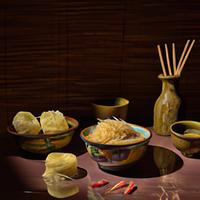
1 serving (56 grams) contains 204 calories, 6.7 grams of protein, 0.8 grams of fat, and 42.0 grams of carbohydrates.

Log this food in SnapCalorie

Nutrition Information
Calories |
815.4 | ||
|---|---|---|---|
% Daily Value* |
|||
| Total Fat | 3.4 g | 4% | |
| Saturated Fat | 0.7 g | 3% | |
| Polyunsaturated Fat | 0 g | ||
| Cholesterol | 0 mg | 0% | |
| Sodium | 11.2 mg | 0% | |
| Total Carbohydrates | 168 g | 61% | |
| Dietary Fiber | 6.7 g | 23% | |
| Sugars | 4.5 g | ||
| protein | 26.9 g | 53% | |
| Vitamin D | 0 mcg | 0% | |
| Calcium | 44.8 mg | 3% | |
| Iron | 4.0 mg | 22% | |
| Potassium | 268.8 mg | 5% | |
* Percent Daily Values are based on a 2,000 calorie diet. Your daily values may be higher or lower depending on your calorie needs.
Food Attributes
Source of Calories
About Dried noodles
Dried noodles are a staple in numerous cuisines, notably Asian, including Chinese, Japanese, Korean, and Thai food traditions. Typically made from flour, water, and sometimes salt or eggs, they come in a variety of shapes and textures, ranging from thin vermicelli to thick udon. Many varieties are low in fat and can be a good source of carbohydrates, providing energy for the body. However, some types, such as instant noodles, may contain added sodium, preservatives, and unhealthy fats due to processing. Pairing dried noodles with fresh vegetables, lean proteins, and broths can enhance their nutritional value while reducing less healthy aspects. Rich in versatility, they serve as the base for countless dishes, such as stir-fries, soups, and cold salads, offering both convenience and culinary creativity to home cooks and chefs alike. Always check labels to understand specific ingredients and nutritional content.



